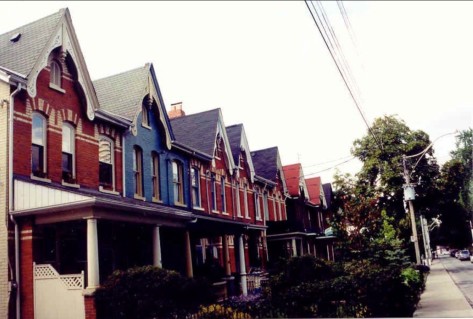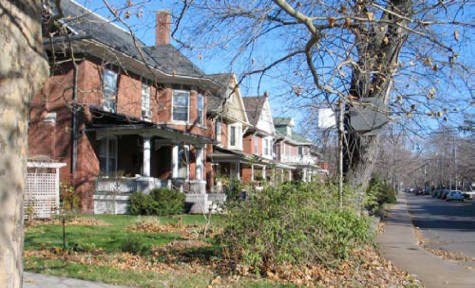Of History and Historical Preservation
by Richard White
A blog written specifically for Active History and posted on their site over a year ago (3 February 2017), now being re-posted here. It’s not about planning, directly, but it stirred up interest among planners so it seems to belong.
Some ten or fifteen years ago a group of residents in my Toronto neighbourhood, a pre-WWI ‘streetcar suburb’ known locally as the Beaches, began the process of making parts of it a Heritage Conservation District, a designation that would impose controls on physical changes to buildings. My immediate response was to oppose them. I was not entirely sure why, and I was somewhat surprised at my own reaction. I enjoyed the ambience of our hundred-year-old streets, as well as the many conveniences that come from pre-automobile residential densities, but the idea of a municipal bylaw freezing these physical qualities in place seemed wrong.
The initiative died within a year or two. The City found, through formal surveys, that more residents opposed than favoured it and took no further action. My street was saved from the preservationists and, as things have turned out, recently acquired a splendid new modern home – all flat and square – on a double lot formerly occupied by a 1940s house.
But the experience lived on in my own mind as I pondered why I, as a historian, should have opposed the initiative. History and preservation always go together, as do historians and preservationists. Nearly all historically-minded people I know are heritage advocates. Every ‘historical association’ I have ever encountered exists to preserve the past. Indeed, a group called the Toronto Historical Association gives as its mandate “educating, researching, protecting and advocating for heritage in Toronto”. But why should this be so? As I reflected on it, I began to realize that I opposed preservation because I was a historian.

Boundaries of the recently-designated St Lawrence HCD – a somewhat more conventional heritage district in that it includes numerous heritage buildings, some already individually designated, and the city’s ten-block founding street grid. (City of Toronto)
An urban neighbourhood undoubtedly speaks to us about the world in which it was made. Indeed a foundational principle of urban landscape studies is that the built environment is essentially a large, three-dimensional historical source. And sure enough, to those who take the time to look, houses in my early-twentieth-century neighbourhood reveal: a parsimonious new middle class (houses are small), members of which did not yet have cars (no space between houses for driveways), whose families were large (bedrooms were small), who did not overindulge in personal hygiene (one bathroom per house), were ambivalent about natural light (few windows), and wore sweaters indoors in winter (minimal insulation). The houses themselves have an unimaginative standard design, show competent if unrefined workmanship, and are adorned with occasional mass-produced touches of elegance – all of which reflect the social class for which they were built.
But that is not us. So far removed are we from Edwardian Toronto that one cannot begin to count the differences. Why then do we want to preserve and inhabit the homes that ‘middle-class’ Edwardians built?
First of all, we do not, really. Owners of these charming old houses knock out walls to create fewer bedrooms (for smaller households), build bathrooms on every floor, increase the size of water-supply pipes, park (multiple) cars on front and back yards, build decks for al fresco dining, punch holes in walls for windows, insulate like mad, re-wire to permit greater electricity consumption, and so on – all of which is permissible because Heritage Conservation District designation, according to provincial law, prohibits the alteration of “any part of the property, other than the interior.” So the truth is that we want our houses to look like, but certainly not to function as, they did a hundred years ago. As a historian who knows and cares about the past this all seems a little dishonest.

A nicely-restored, well-maintained residential Street in the Cabbagetown-Metcalfe HCD, 2002 (City of Toronto – City Planning / Urban Design / Cabbagetown-Metcalfe HCD)
But I would go even further and say that superficial preservation actually distorts history by papering over the austerity and insecurity of early 20th century life with a tableau of present-day comfort and security, and I think this is what irks me most. It is so easy to forget, when strolling along a nicely-preserved, pre-WWI Toronto street, that nearly every original family in those houses would have experienced an infant or childhood death. Admittedly, exterior fronts of houses do reveal something about the period in which they were built – architectural façadism has its defenders – but it is the interiors, blithely gutted and tossed into disposal bins, that really show the values and customs of the time they were built. I also cannot escape the fact that the urban landscapes we seek to preserve are but a single historical moment. Even setting aside the centuries-old presence of Wendat or Ojibwa people in my neighbourhood, which is important but hard to determine, what of the entire 19th century when my neighbourhood was farmland? Why should the construction of a residential suburb in 1910 be the immortalized moment?

Housing in the Lyall Avenue HCD – a distinctive upper-middle class street in East Toronto, early twentieth century. Its large brick houses on large lots stand apart from the much smaller lower-middle class housing around them, and seem more like housing in a small Ontario town than Toronto. (City of Toronto – City Planning / Urban Design / Lyall Avenue HCD)
We are, in truth, a people of smart phones and engineered wood, of automobiles and expanded horizons, of individuals more than of families, of unprecedented affluence and cleanliness, too busy to actually sit on our porches, and whose children would rather play indoors than out – and I see few, if any, signs of us abandoning these newly-acquired customs and values. Is there not something unsettling – especially to a person who knows the past – about our desire to preserve the appearance of another age’s built form, and our reluctance to outwardly express our own? Interestingly, they who made the urban landscapes we now strive to preserve were not so equivocal. They felt no need to shore up and retain the shacks and farmhouses they were supplanting, or to fence off and preserve disused barns in the midst of new residential suburbs. In doing so they left clear evidence of who they were, and we historians benefit from their forthrightness. Perhaps, to take this to its logical end-point, we are showing who we are to future historians – a conflicted people, trying obsessively to preserve a world we have lost as we immerse ourselves in a world we do not trust. But I have never heard that as the rationale for preservation.
Complicating matters further is that, for the most part, preserved neighbourhoods are gentrified neighbourhoods. Looking over the list of Heritage Conservation Districts on the City’s website – which, among other things, reveals how widespread preservationism has become in Toronto – it is clear that tony neighbourhoods led the way. This is not surprising. Preservationism is easier to espouse when one can afford to care more about the authenticity than the cost of brass house numbers or wood mouldings. Preserving the historical features of a house undoubtedly costs more than not preserving them, so preservationism is bound to have a stream of social inequality running through it.
The troublesome manifestation of this is that preserved/gentrified neighbourhoods are showing themselves to be rather unwelcoming to outsiders. This, to my knowledge, has not been empirically studied, but it certainly seems to be so. Perhaps preserved houses turn over less often on account of their owners’ pride of ownership, or perhaps they cost more, or maybe prohibiting the intrusion of multi-unit residential buildings prohibits the entry of newcomers. The only part of Toronto I have observed in detail in this regard is Saint James Town, where preserved South SJT is occupied (at low density) by reasonably affluent gentrifiers – many of them ‘old-stock Canadians’ – while the towers of SJT proper, always held up as what NOT to do in cities, are home to thousands of lower-income renters, many of them immigrants. Surely there is no necessary connection between preservationism and xenophobia, but the similarity of their outcomes cannot be overlooked.

Cottage-style row housing dating from the 1880s on Draper Street, an HCD designated in 1999. The designation keeps new construction at bay, even in a downtown commercial district such as this near King and Spadina. (City of Toronto – City Planning / Urban Design / Draper Street HCD)
Where do these ruminations lead? I, for one, certainly do not want to see the whole city rebuilt with square flat modern structures – if that is indeed the built form that expresses our 21st century urban culture. I enjoy the old city as much as anyone. Moreover, I note that notwithstanding the demand for HCD designations by property owners the City itself is not doling out designations improvidently, and the studies on which designations are based seem very thorough and the recommendations they make perfectly level-headed. Current policies seem not to have put us on the road to ruin, as far as I can see.
Yet I find it unsettling, as both a historian and a citizen, that so much of the city wants to preserve itself – we have, after all, inside-the-walls Paris to remind us what happens when an entire city becomes a protected historical landscape – and I believe that there are reasonable, historically-informed arguments against preservationism. One of the miraculous things about complex ecosystems, cities included, is that the multifarious forces within them, left on their own, seem capable of finding their own balance. Perhaps we should not worry so much about letting the present express itself.
